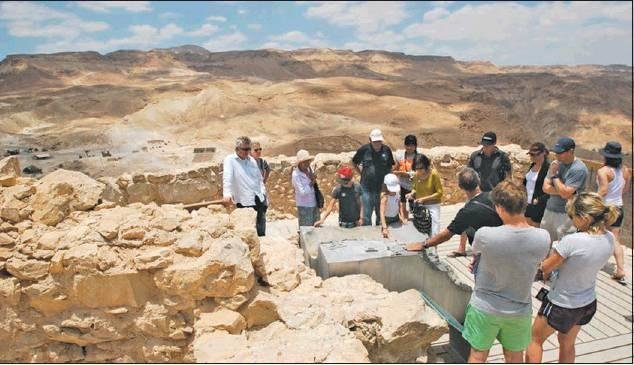What did the Masada rebels hope to achieve?
Chronicle Editor Emeritus Jerry Bellune shares with you his adventures in the Holy Land. The experience gave him a greater appreciation of shared US and Israeli values.
Masada, Judea
…
This item is available in full to subscribers.
Subscribe to continue reading. Already a subscriber? Sign in
Get 50% of all subscriptions for a limited time. Subscribe today.
Please log in to continueNeed an account?
|
What did the Masada rebels hope to achieve?
Chronicle Editor Emeritus Jerry Bellune shares with you his adventures in the Holy Land. The experience gave him a greater appreciation of shared US and Israeli values.
Masada, Judea
Would you be willing to live precariously on a rocky mesa 1,300 feet above the Judean desert for 3 years?
Most of us would say no.
But if the rest of your short life and that of your loved ones might be spent as slaves of the Roman empire, you might think differently.
That was what the rebels and their families faced if they came down off the crest of Masada.
Hundreds of tyrants and despots have discovered over centuries is that freedom is more than an idea.
It is a powerful desire that may be snuffed out like a candle by a stronger and oppressive enemy. But one day it will reignite itself.
The lone reason the British crown and Parliament were able to hold American colonists in servitude so long was that many of them felt an affection for the king and a love for the country they had left behind.
The rebels on Masada knew what would happen to them if they gave up.
The Romans prided themselves as feared enemies.
When you can intimidate your enemies as the Romans did in Europe and the British isles, you can overwhelm resistance with little cost of your soldiers’ lives.
A royal history
Masada’s height was a valuable piece of real estate for Jewish kings.
Herod the Great built palaces for himself on the mountain and fortified Masada around 37 BC.
We know of this due to the accounts of a 1st Century Jewish journalist and historian named Josephus.
As far as we known, Josephus was the lone scribe and had an exclusive story.
He recorded the siege of Masada by the Roman legions at the end of the First Jewish–Roman War.
I’m giving away the end of the story but you should know that it ended in the mass suicide of 960 Sicarii rebels and their families.
The cliffs of Masada is, geologically speaking, a horst. That’s a raised block of the earth’s crust lying between two faults.
The eastern cliffs of Masada are about 1,300 feet tall – the height of the Empire State Building.
The western cliffs are about 300 feet – a 30-story building or 5 times the height of our county administration building.
The approaches to the cliff top are difficult to climb. Now that Masada has become a great tourist attraction, the Israelis have erected a cable car system to take you to the top.
The Romans had no such engineering knowledge. But they did come up with a way to reach the summit – but it was too late.
Home to the rebels
The top of the Masada plateau is flat – about the size of 6 football fields long and 3 football fields wide.
It was home for 3 years to almost 1,000 people holding out against 8,000 Roman legionnaires encircling their fortress heights.
The rebels had erected a casemate wall around the rim of the plateau 4,300 feet long and 13 feet high. They built towers, warehouses, barracks, an armory and cisterns refilled by rain.
Three narrow, winding paths led up to fortified gates near the summit.
Almost all historical information about Masada comes from Josephus.
He wrote that the site was first fortified by the Hasmonean ruler Alexander Jannaeus in the 1st century BC. He is probably right although archeologists have found no Hasmonean-period building remains.
According to Josephus, Herod the Great captured it in a power struggle after the death of his father Antipater.
In 66 AD, a group of Jewish rebels overcame the Roman garrison of Masada with the aid of a ruse.
After the destruction of the 2nd Temple in 70 AD, rebels fled Jerusalem and settled on the mountaintop after slaughtering the Roman garrison.
The Sicarii rebels were an extremist Jewish group antagonistic to the Jewish Zealots, who carried the main burden of the rebellion against the Romans.
The Sicarii extremists raided Jewish villages and killed women and children.
Next: The Romans seek revenge at Masada.
Other items that may interest you







Comments
No comments on this item Please log in to comment by clicking here